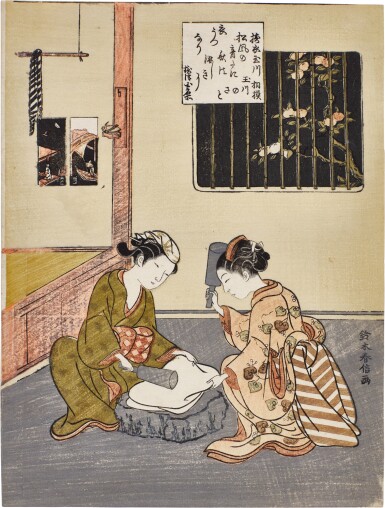Fine Japanese Prints
Fine Japanese Prints

Suzuki Harunobu (1725-1770) | The Cloth-fulling Jewel River, a Famous Place in Settsu Province (Toi no Tamagawa, Settsu no meisho) | Edo period, 18th century
Lot Closed
December 16, 02:04 PM GMT
Estimate
7,000 - 9,000 GBP
Lot Details
Description
Suzuki Harunobu (1725-1770)
The Cloth-fulling Jewel River, a Famous Place in Settsu Province (Toi no Tamagawa, Settsu no meisho)
Edo period, 18th century
woodblock print, from an untitled series of Six Jewel rivers (Mu Tamagawa), signed Suzuki Harunobu ga (Pictured by Suzuki Harunobu), circa 1766-67
Vertical chuban: 27.6 x 20.8 cm., 10⅞ x 8¼ in.
One of a series of scenes from the Six Jewel Rivers (Mutamagawa). This print illustrates two women, probably a mother and daughter, beating cloth under a candle hung on the pillar in an earthen-floored room. The fulling of cloth signifies a quiet autumn evening. Seen through a bamboo window is a tree with persimmons, another autumnal motif. A single towel hung over a rod deepens the homely but lonely atmosphere.
Two small prints on the wall illustrate fireworks near a bridge over the Sumida River in Edo in summer and the viewing of the moon in autumn. They are depicted as benizuri-e, examples of an old printmaking method that used only two colours. The appearance of these benizuri-e within a polychrome colour print, demonstrating the new "brocade" technique invented by Harunobu, allowed the viewer to savour the contrast.
The subject of Mutamagawa, developed from the classical theme of beautiful rivers employed to represent famous scenic places in waka poems, was eventually standardized, probably in the Edo period, to form a group of six Jewel Rivers. As described in the poem, this scene depicts the Jewel River flowing through a renowned picturesque location in Settsu, modern Osaka:
The poem by has been translated by Miyeko Murase1:
Fulling of Cloth at Tamagawa by Lady Sagami
The autumn wind over the pines sounds forlorn.
In the loneliness, the sound of fulling cloth at Tamagawa.
Matsukaze no
oto dani aki wa
sabishiki ni
koromo utsu nari
Tamagawa no sato
The poem was actually composed by Minamoto Toshiyori (ca. 1055-1129), not by Lady Sagami, as stated in the inscription.
1. https://www.metmuseum.org/art/collection/search/60027586
For a different impression of the same print in the collection of the Museum of Fine Arts, Boston, accession number 50.3601, go to:
